Abstract
The Ganges–Brahmaputra–Meghna (GBM) delta, characterized by complex topography and hydrological conditions, is highly susceptible to recurrent flooding, particularly in its coastal regions where tidal dynamics hinder floodwater discharge. This study integrates Synthetic Aperture Radar (SAR) imagery with machine learning (ML) techniques to assess near real-time flood inundation patterns associated with extreme weather events, including recent cyclones between 2017 to 2024 (namely, Mora, Titli, Fani, Amphan, Yaas, Sitrang, Midhili, and Remal) as well as intense monsoonal rainfall during the same period, across a large spatial scale, to support disaster risk management efforts. Three machine learning algorithms, namely, random forest (RF), support vector machine (SVM), and K-nearest neighbors (KNN), were applied to flood extent data derived from SAR imagery to enhance flood detection accuracy. Among these, the SVM algorithm demonstrated the highest classification accuracy (75%) and exhibited superior robustness in delineating flood-affected areas. The analysis reveals that both cyclone intensity and rainfall magnitude significantly influence flood extent, with the western coastal zone (e.g., Morrelganj and Kaliganj) being most consistently affected. The peak inundation extent was observed during the 2023 monsoon (10,333 sq. km), while interannual variability in rainfall intensity directly influenced the spatial extent of flood-affected zones. In parallel, eight major cyclones, including Amphan (2020) and Remal (2024), triggered substantial flooding, with the most severe inundation recorded during Cyclone Remal with an area of 9243 sq. km. Morrelganj and Chakaria were consistently identified as flood hotspots during both monsoonal and cyclonic events. Comparative analysis indicates that cyclones result in larger areas with low-level inundation (19,085 sq. km) compared to monsoons (13,829 sq. km). However, monsoon events result in a larger area impacted by frequent inundation, underscoring the critical role of rainfall intensity. These findings underscore the utility of SAR-ML integration in operational flood monitoring and highlight the urgent need for localized, event-specific flood risk management strategies to enhance flood resilience in the GBM delta.
Keywords:
cyclone; inundation; monsoon rainfall; machine learning (ML); SVM; RF; KNN; Synthetic Aperture Radar (SAR) 1. Introduction
Owing to its unique topography, hydrological setting, and geographic location, the Ganges–Brahmaputra–Meghna (GBM) delta has long been highly susceptible to flooding. Particularly in the coastal regions, hydro-geomorphological vulnerabilities render the area prone to large-scale inundation, while tidal fluctuations in the downstream sections of the delta impede the efficient downstream flow of floodwaters [1]. Flooding in the coastal belt is primarily driven by the delta’s flat terrain, intense rainfall over the three upstream basins [2], and the recurrent occurrence of cyclonic storm surges [3]. The coastal zone of the GBM delta experiences both cyclone-induced storm surge flooding and monsoonal flooding, although the simultaneous occurrence of these events is rare [4]. When cyclones make landfall, the combined effects of intense rainfall and associated storm surges result in widespread flooding. The pre-monsoon period from April to June and the post-monsoon period spanning between October and November are typically when cyclone-induced inundation occurs [5], whereas monsoonal rains during July–September often overwhelm drainage systems, leading to prolonged waterlogging in low-lying areas.
With projections indicating a rise in both the cyclonic surges and sea levels, the scale and impact of inundation across the deltaic coastline are likely to worsen in the coming decades [6]. Flooding remains the most widespread natural hazard in the region, causing significant human casualties and economic losses. Consequently, the development of effective flood warning and disaster response systems has become increasingly urgent [7]. Near real-time flood monitoring and inundation mapping are critical for a timely response during such events [8]. However, implementing reliable and timely flood monitoring systems remains challenging due to the need for high-quality, real-time data [9].
In this context, remote sensing technology has been gaining prominence since the 1990s as an essential tool for the detection and surveillance of flood-prone areas [10]. Both optical and microwave satellite data have been extensively used in monitoring floods and mapping areas of inundation [11]. However, optical sensors are less reliable under cloud-heavy conditions, which commonly accompany monsoons and cyclones [12]. Synthetic Aperture Radar (SAR), in contrast, offers a powerful alternative due to its all-weather imaging capability. SAR has proven effective in global flood mapping efforts for its ability to penetrate clouds and accurately differentiate between water and non-water surfaces [13]. Its use of lower microwave frequencies enhances this capacity by improving the contrast between inundated and non-inundated areas, making SAR a preferred tool for assessing floods in near real time [14,15]. However, SAR imagery comes with certain limitations, such as the presence of speckle noise, which results from the interference of radar signals reflected by multiple small scatterers [16,17]. Differentiating between standing water, saturated soil, and smooth surfaces such as asphalt can also pose challenges. Despite these constraints, SAR imagery remains a valuable tool for operational flood mapping, especially when combined with ancillary data and machine learning (ML) techniques to improve classification accuracy and reduce uncertainty. Moreover, most SAR-derived inundation mapping approaches have not been extensively validated over large geographic areas [17]. Consequently, optimizing flood and non-flood classification thresholds based on backscatter values is critical for improving mapping accuracy.
Recent advancements in flood detection and mapping have seen extensive use of ML integrated with remote sensing data, particularly SAR imagery. To improve the SAR-based flood detection and monitoring accuracy, a range of ML algorithms have been evaluated, including support vector machines (SVM) [18], random forest (RF) [19], decision trees [20], hidden Markov trees (HMTs) [21], logistic regression (LR) [22], and maximum likelihood (MLL) [23]. These models have consistently demonstrated their effectiveness in differentiating inundated areas from non-water surfaces, offering significant advantages during the monsoon season when the presence of cloud cover reduces the utility of optical satellite imagery. These models leverage environmental and hydrological predictors, including topography, soil characteristics, land use/land cover (LULC), and precipitation data, to assess flood susceptibility.
By employing RF and SVM classifiers, inundated and non-inundated areas in Kerala and Assam, India, were compared, and the conclusion was made that RF, especially with VV polarization, performed better in flood extent delineation [24]. Similarly, supervised (RF, SVM, MLC) and unsupervised models were developed for urban flood detection in San Diego, combining SAR data with road closure alerts [25]. Their findings indicated that SVM and unsupervised change detection methods (Otsu algorithm, fuzzy logic, iso-clustering) delivered high accuracy. RF, CNNs, and GIS were integrated with Sentinel-1 data in Palembang to create detailed flood risk maps, successfully managing complex spatial-temporal patterns [26]. Object-based classification using RF was employed for analyzing SAR time series data, leveraging backscatter coefficients, coherence, and multi-scale segmentation for flood mapping, achieving a 96% classification accuracy [27].
Other studies reinforced the importance of integrating various datasets for improved ML performance. Gradient boosting (GB) and RF were employed to detect the extent of flooding and analyze water depth with Sentinel-1, Sentinel-2, and DEM datasets covering Mexico, with GB outperforming RF in most cases [28]. Flood susceptibility in West Bengal was assessed using six ML models, where the Stacking Ensemble approach yielded the highest predictive accuracy, followed by XGBoost and DNN, based on 18 flood-related parameters [29]. Flood mapping was improved in complex terrains using QDA, SVM, and KNN classifiers alongside HAND data, finding QDA and SVM most effective, particularly in areas with dense vegetation and urban coverage [30]. Collectively, these studies emphasize the growing reliability and adaptability of ML in flood detection and mapping across diverse landscapes and hydrological conditions. Despite increasing interest in remote sensing applications, the synergistic use of SAR imagery and ML algorithms for inundation mapping along the GBM delta coastline is still limited, with only a few emerging studies [31,32] exploring its potential.
The frequency and spatial extent of severe weather events are increasing as climate change impacts are intensifying, with the GBM delta, particularly the coastal region of Bangladesh, facing significant consequences [33]. The growing frequency and intensity of extreme weather events have exacerbated flood risks in deltaic regions, particularly in densely populated areas [34]. While Bangladesh has made considerable progress in reducing fatalities associated with tropical cyclones, the broader socio-economic impacts, including economic losses, continue to escalate [35]. Historical storm data from the Bay of Bengal reveal a bimodal distribution in cyclone frequency, with peaks typically occurring in May and November [36]. On average, the country faces a major cyclone event, characterized by inundation across 26–34% of the area, every three years [37,38]. Analysis of past cyclonic landfalls indicates that districts such as Satkhira, Bagerhat, Barguna, and Patuakhali have been most frequently affected over the last 137 years [39]. Additionally, cyclones making landfall in adjacent coastal areas of West Bengal, India, often extend their impact into the interior coastal region of Bangladesh, such as Jessore and Jhenaidah [39]. Importantly, the spatial extent and severity of disaster impacts are not static but vary over time, underlining the need for dynamic assessment approaches [40]. With increasing urban expansion, flood exposure is expected to increase, contributing to elevated flood risk across all sources [41].
The current flood monitoring system in Bangladesh, led by the Flood Forecasting and Warning Centre (FFWC) under the Bangladesh Water Development Board (BWDB), presents several limitations that hinder comprehensive flood assessment. Established in 1972, FFWC primarily relies on river water level data from 110 stations nationwide [42], with updates disseminated via its official website [43]. However, this river-centric approach overlooks rainfall-induced flooding, especially in flat, low-lying coastal areas where localized precipitation can cause significant inundation. Furthermore, the FFWC’s model domain excludes coastal and South-Eastern regions, limiting the applicability of its outputs for flood analysis and verification in these vulnerable zones [44]. While it produces inundation maps by combining river water level forecasts and digital elevation models (DEMs) till 2023, these maps lack the ability to capture the dynamic nature of floods.
Initially, FFWC used MODIS optical imagery for flood mapping [45], but due to cloud interference during monsoons, it adopted Sentinel-1 SAR data in 2021 for more reliable flood detection [44]. Despite this improvement, operational constraints still limit the production of timely, event-specific inundation maps, underscoring the need for more comprehensive and adaptive monitoring frameworks that integrate diverse flood drivers and regions.
Against this backdrop, the present study aims to analyze recent extreme weather events, namely Cyclones Mora (2017), Titli (2018), Fani (2019), Amphan (2020), Yaas (2021), Sitrang (2022), Midhili (2023), and Remal (2024), along with seasonal heavy monsoonal rainfall events from 2017 to 2024. By utilizing SAR imagery and ML techniques, this research seeks to produce high-resolution inundation maps and examine flood dynamics across diverse coastal regions. Specifically, the study focuses on optimizing change detection thresholds using machine learning methods, mapping the temporal and spatial patterns of inundation, and delineating zones with elevated flood risk based on recurrence analysis.
2. Study Area
The Ganges–Brahmaputra–Meghna (GBM) Delta, covering approximately 100,000 square kilometers of subaerial land, is located at the northern boundary of the Bay of Bengal and constitutes one of the world’s largest and most complex deltaic systems [46,47]. The coastline of this delta within Bangladesh is our study area, as shown in Figure 1. Much of the terrain lies less than 3 m above mean sea level, allowing tidal effects to penetrate nearly 100 km inland, rendering about one-fourth of Bangladesh a coastal region [48,49]. The GBM rivers collectively drain around 75% of the Himalayan range [46,50,51].
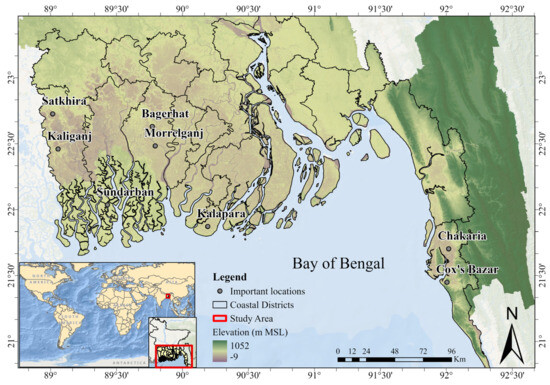
Figure 1.
Study area.
This region’s physical and climatic setting, governed by monsoonal systems, low elevation, and the convergence of major river systems, makes it especially vulnerable to hydro-meteorological hazards [48]. In fact, more than 60% of Bangladesh was inundated during past extreme flood events [44,52]. The country regularly experiences five primary types of natural floods: river floods, rainfall-induced (or pluvial) floods, flash floods, tidal floods, and storm surge events. Key flood-prone zones include the northwestern districts (e.g., Kurigram and Gaibandha) and central floodplains (e.g., Sirajganj and Jamalpur), which are predominantly affected by riverine flooding; the northeastern haor regions, which are prone to flash floods; and the coastal districts (e.g., Satkhira, Khulna, and Barguna), which experience a combination of pluvial, fluvial, and tidal inundation. This study focuses specifically on the coastal belt, a region that has experienced multiple extreme weather events in recent years and remains highly vulnerable to compound flooding hazards. For example, Cyclone Remal (May 2024) made its landfall near Mongla and Khepupara coasts, causing surges up to 5–8 feet, impacting major parts of the western and central coast [53]. Alongside cyclonic threats, monsoon-induced inundation, increasingly driven by extreme rainfall and waterlogging, poses severe challenges for low-lying coastal zones [54,55]. In the four largest major river basins, namely the Ganges, Brahmaputra, Meghna, and the Southeastern Hill basin, monsoon rainfall typically ranges from 1000 to 2900 mm, with an average of approximately 2300 mm [44]. Shifting monsoon patterns, marked by fewer light rain events and more intense downpours, have exacerbated flooding and water stagnation, especially in southern districts [56].
3. Data and Methods
3.1. Data Sources
As SAR imagery is available from 2017 onwards for the GBM delta coastline within Bangladesh, only images from this period were utilized for the analysis. To identify monsoonal flood events, area-averaged daily accumulated rainfall data from the Global Precipitation Measurement (GPM) mission were collected for the coastal region of Bangladesh for the years 2017 to 2024. The annual rainfall data were analyzed to identify peak rainfall events, and the event associated with the most extensive inundation was selected for flood mapping, as summarized in Table 1. For both monsoonal rainfall and cyclone-induced flooding, SAR images were acquired corresponding to the peak rainfall day and landfall dates of major cyclonic events, which are also mentioned in Table 1.

Table 1.
Peak rainfall and cyclone events.
3.2. Methodology
3.2.1. Analysis of SAR Images
In this study, Sentinel-1 level-1 Ground Range-Detected (GRD) imagery with VV polarization is utilized on the Google Earth Engine (GEE) platform for inundation mapping along the GBM coastline in Bangladesh. The preprocessing of Sentinel-1 GRD imagery followed a standardized workflow to ensure radiometric and geometric consistency prior to flood detection analysis. Initially, orbit metadata were updated using restituted orbit files to enhance geolocation accuracy. Low-intensity noise and invalid data near scene edges were then removed to reduce boundary artifacts. Subsequently, additive noise present in the sub-swaths—common in multi-swath acquisition modes—was corrected to minimize radiometric discontinuities across the scene. Radiometric calibration was conducted to derive backscatter intensity (σ°) by applying sensor-specific calibration constants embedded in the GRD metadata. Finally, terrain correction was applied to convert the data from ground range to σ° backscatter in map geometry, incorporating the Shuttle Radar Topography Mission (SRTM) 30-m digital elevation model (DEM) to account for topographic distortions. σ° can span several orders of magnitude; it was subsequently converted to decibels (dB) scale using the transformation 10·log10 (σ°) to facilitate analysis and interpretation. On the GEE platform, the Sentinel-1 GRD dataset undergoes a standardized preprocessing workflow comprising orbit metadata updates, elimination of low-intensity noise and invalid edge data, sub-swath additive noise correction, radio-metric calibration, orthorectification, and transformation of the backscatter coefficient (σ°) to decibels (dB) units [57]. To reduce speckle noise inherent in SAR imagery, a focal mean filter was applied using a 50-m smoothing radius within the Google Earth Engine (GEE) platform. This spatial averaging technique helps preserve broad-scale features while minimizing high-frequency noise, thereby enhancing the quality of the backscatter signal for subsequent analysis.
For inundation mapping, a change detection approach was employed, wherein a raster layer representing pixel-wise change intensity was generated by normalizing the post-flood SAR mosaic against the pre-flood mosaic. In this layer, higher values indicate significant surface change, while lower values suggest minimal or no change. A threshold value named was applied; pixels with values exceeding this threshold were classified as inundated (1), and those below it as non-inundated (0). was determined through ML algorithms. The details of determination algorithm was discussed in Section 3.2.2. The methodology of SAR image analysis is shown briefly in Figure 2. To improve classification accuracy and reduce false positives, several auxiliary datasets were integrated, notably using the JRC Global Surface Water dataset to exclude permanent water bodies.
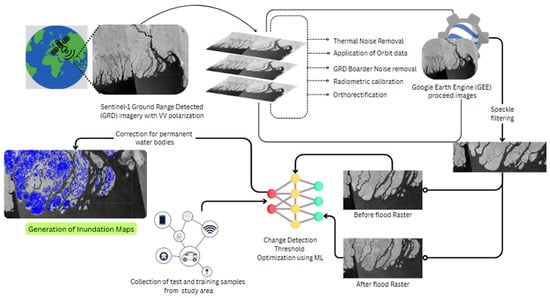
Figure 2.
Methodology for SAR image analysis.
3.2.2. Estimation of Change Detection Threshold,
Data Preparation and Splitting
Three supervised machine learning algorithms, namely, SVM, RF, and KNN, were employed for the determination of the change detection threshold . The models classified flood extents based on radar backscatter characteristics and were trained using field data and simulated flood extent layers for the recent cyclone and rainfall events. The flood point and non-flood point dataset from the study area (Figure 3) was split evenly, allocating 50% for training and 50% for testing.
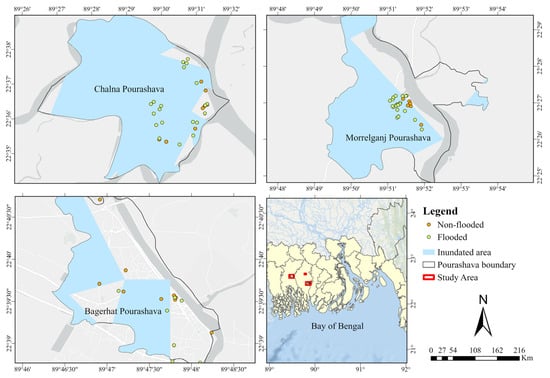
Figure 3.
Location of flood and non-flood points derived from the study area.
Class Imbalance Analysis and Bias Mitigation
Prior to model training, class imbalance was assessed and addressed to reduce potential bias due to the unequal distribution of flooded and non-flooded samples. To measure the class imbalance, the imbalance ratio (IR) [58] was calculated using Equation (1).
where and denote the number of samples in the majority (flooded) and minority (non-flooded) classes, respectively.
Stratified sampling [59] was then applied during the train-test split to ensure that class proportions remained consistent across subsets. The class proportion in the training set was aligned with the original dataset distribution , as defined in Equation (2):
where represents the class label.
Additionally, class weights were computed and incorporated into the RF and SVM models using a balanced weighting scheme [60]. This gave more influence on the minority class during training, thereby helping to mitigate classification bias.
Class weights were computed using Equation (3):
where is the weight assigned to class , is the total number of samples, is the number of classes (2 for binary classification in our case), and is the number of samples in class .
Model Configuration and Hyperparameter Tuning
Model configurations were tailored for each algorithm. The RF model used 100 estimators with a maximum depth of 15, along with class weighting to address class imbalance, enabling it to capture moderately complex, non-linear interactions. The SVM model employed a polynomial kernel of degree 3 with balanced class weights to effectively model non-linear decision boundaries. Meanwhile, the KNN classifier was implemented using the Euclidean distance metric (Minkowski distance with p = 2) and a neighborhood size of k = 5. Each model underwent hyperparameter tuning via cross-validation to optimize classification accuracy.
Feature Importance in Machine Learning Models
Feature importance () analysis varied by model type. For the RF model [61], feature importance was calculated using the mean decrease in impurity (MDI) method, which measures the average Gini impurity reduction achieved when a feature is used to split nodes across all decision trees and was calculated using Equation (4).
where:
- o
- is the reduction in impurity (e.g., Gini) at split for tree
- o
- represents the set of splits in which the feature was used
- o
- is the number of trees in the random forest
- o
- is the total impurity at the root node
In the case of the SVM (with a linear kernel for interpretability) [62,63], the importance of each feature was proportional to the absolute value of its corresponding weight in the hyperplane equation. The SVM optimization formulation is presented in Equation (5).
where:
- o
- is the weight vector (coefficients for each feature)
- o
- is the bias term,
- o
- is the input feature vector
- o
- is the class label
The feature importance is given by the absolute values of the components of the weight vector:
KNN, lacking a parametric model structure, did not provide inherent feature importance [64]; instead, its utility was evaluated based on test set accuracy using Equation (6). To facilitate comparison across models, min–max normalization was applied to all raw feature importance scores.
Accuracy is defined as the proportion of correct predictions:
Model Evaluation
Subsequently, a precision-recall analysis was performed to explore the trade-off between detecting true flood events and minimizing false alarms. Precision, Recall, and the F1 score were calculated for different classification thresholds. This analysis helped identify the optimal threshold that balanced sensitivity and specificity, enhancing the reliability of flood detection.
Precision, Recall, and F1 score were calculated using Equations (7)–(9).
To further verify the optimal threshold, receiver operating characteristic (ROC) curves and the area under the curve (AUC) metric were employed. The ROC curve illustrated the relationship between the true positive rate (TPR) and the false positive rate (FPR) across different thresholds [65,66]. The TPR is also known as sensitivity or recall and is defined with the same equation as Recall as shown in Equation (9).
The FPR is defined according to Equation (10).
where:
- o
- is the number of false positives
- o
- is the number of true negatives
AUC was computed as the integral of the ROC curve, with values close to 1 indicating excellent model performance in distinguishing between flooded and non-flooded classes. Mathematically, the AUC can be expressed according to Equation (11).
Statistical Significance Evaluation
Finally, the statistical significance of model performance was evaluated using the paired t-test and McNemar’s test. The paired t-test assessed whether the observed performance differences across models were statistically significant over multiple validation folds [67]. It is defined by Equation (12).
where is the mean of the differences between the performance measures of the two classifiers, is the standard deviation of these differences, and is the total number of observations.
McNemar’s test [67] was used to compare the prediction outcomes of two classifiers on the same dataset, particularly focusing on cases where the models disagreed. The test statistic (), with Yates’ continuity correction, is calculated using Equation (13)
where represents the number of instances where the classifier demonstrates significant predictive capability in one scenario, and represents the number of instances where the classifier shows significant performance in another scenario.
Together, these tests ensured the robustness and reliability of the comparative model evaluation.
3.2.3. Identification of Flood-Affected Zones
The flood-affected zones were determined based on the inundation frequency of each grid cell. Specifically, a grid cell is considered to fall within a low flood-affected zone if it is inundated in at least 40% of the events, corresponding to 3 or fewer events during peak monsoon rainfall and cyclonic events. Cells inundated in 41% to 80% of events, equivalent to 4 to 6 events, are categorized as moderately flood-affected. Finally, cells inundated in more than 80% of the selected events or more events are classified as highly flood-affected.
4. Results
4.1. Optimization of Change Detection Threshold,
In this study, three machine learning algorithms—RF, SVM, and KNN—were applied to classify flood statuses and validated against observed data across a range of flood status thresholds. Among these, the threshold value of 1.025 emerged as the most significant. The RF model, which estimates feature importance through Gini impurity reduction, assigned the highest score of 0.43 to this threshold. Similarly, the KNN model, evaluated based on classification accuracy using individual features, achieved its peak of 0.69 at the same threshold, while the SVM model reported a strong hyperplane coefficient of 0.70, confirming the high relevance of the 1.025 threshold. The field dataset exhibited a moderate class imbalance, with a 2.09:1 ratio between flooded (67.6%) and non-flooded (32.4%) samples, likely reflecting either actual flood prevalence or sampling constraints. To address potential bias arising from this imbalance, class weighting techniques and stratified cross-validation were applied during training, ensuring balanced model evaluation across both classes.
Figure 4 illustrates a comparative analysis of normalized scores, highlighting that RF and SVM effectively handled class imbalance by prioritizing critical features like the 1.025 threshold. In contrast, KNN’s performance was limited by its lack of intrinsic class-balancing mechanisms, showing consistent (68.2%) across thresholds from 1.0 to 1.225 and dropping to random guessing (50%) for low-variance thresholds (≥1.25). As a result, KNN’s normalized appeared binary (0 or 1), reflecting its inability to differentiate informative patterns under imbalance. This contrast emphasizes the superior adaptability of RF and SVM in imbalanced scenarios, as they generated nuanced importance gradients, while KNN struggled to deliver meaningful rankings under similar conditions.
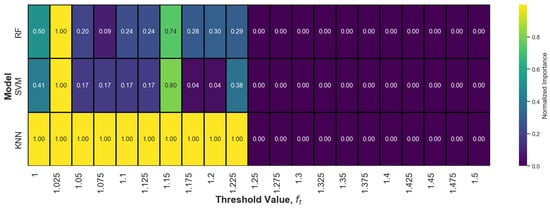
Figure 4.
Comparative analysis of feature importance across machine learning models under class imbalance: RF, SVM, and KNN performance with normalized importance scores.
Figure 5 provides a comparative assessment of three machine learning models using four performance metrics. SVM outperformed both KNN and RF, achieving the highest (0.750), F1-score (0.756), Precision (0.771), and Recall (0.750), indicating consistent and balanced performance. KNN ranked second, while RF showed the lowest scores across all metrics. These results highlight SVM as the most effective model for this classification task.
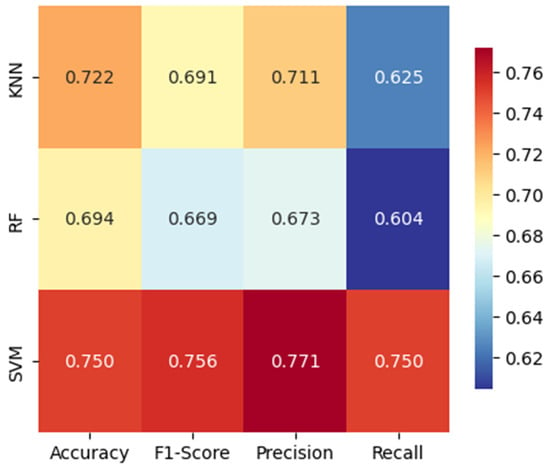
Figure 5.
Performance comparison of RF, SVM, and KNN models on threshold 1.025.
The cross-validation results reveal different performance patterns among the three machine learning algorithms. SVM achieved the highest cross-validation accuracy (0.686 ± 0.0555), demonstrating both superior performance and excellent stability with the lowest standard deviation. KNN showed moderate performance with cross-validation accuracy of 0.662 ± 0.1061, while RF exhibited the lowest cross-validation accuracy (0.646 ± 0.1670) and the highest variability in performance.
Figure 6 shows that the SVM model achieved the highest AUC (0.752), indicating that the dataset favors boundary-based separation, where support vectors effectively maximize class margins. The RF model followed closely with an AUC of 0.743, suggesting limited benefit from its ability to capture complex feature interactions. KNN performed the lowest (AUC 0.719), likely due to sensitivity to high-dimensional data and weak local clustering. The narrow AUC range (0.719–0.752) implies moderate classification complexity, with SVM best aligning with the dataset’s structure.
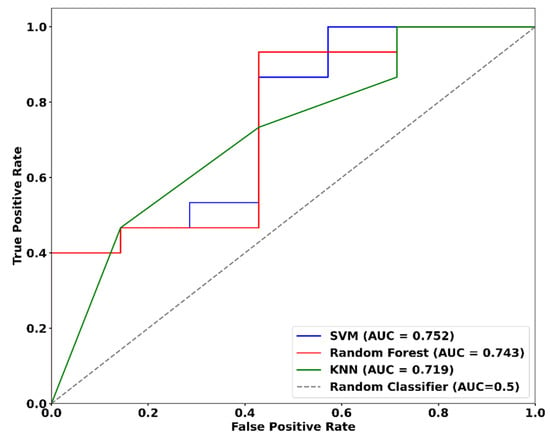
Figure 6.
ROC curves for threshold 1.025 for RF, SVM, and KNN models.
The paired t-test and McNemar’s test results confirm statistically significant performance for all three machine learning models, as shown in Table 2.

Table 2.
Statistical comparison of classification models using paired t-test and McNemar’s test for RF, SVM, and KNN.
4.2. Assessment of Inundation
4.2.1. Inundation Due to Peak Rainfall
Figure 7 presents the area-averaged monsoon rainfall across the study period. For the coastal region of Bangladesh, daily accumulated rainfall of 44 mm/day is considered the threshold for heavy rainfall [68]. Accordingly, rainfall events meeting or exceeding this threshold were selected for inundation analysis. Figure 8 illustrates the corresponding spatial inundation patterns during these events. On 24 July 2017, a peak monsoon rainfall event, with an aerial-averaged rainfall of 110 mm/day, led to extensive inundation across Bagerhat and surrounding areas. In contrast, the eastern coastal region experienced less flooding, with notable inundation limited to areas around Noakhali and Maheshkhali (Cox’s Bazar district) (Figure 8a). The total inundated area was approximately 9639 sq. km. On 10 June 2018, another heavy rainfall event of 132 mm/day caused flooding over 8264 sq. km, primarily affecting the south-central coast, with significant inundation observed in the Pirojpur and Kalapara regions (Figure 8b). The 2019 monsoon season brought relatively light rainfall of 40 mm/day, resulting in a reduced inundated area of 3461 sq. km. Moderate flooding was recorded in parts of the western coast, particularly near Morrelganj and Kaliganj (Figure 8c). In 2020, rainfall reached 110 mm/day, leading to an inundation area of 5396 sq. km, with major impacts near Morrelganj and Amtali (Barguna district), while the rest of the coast experienced minimal flooding (Figure 8d). During the 2021 monsoon, rainfall of 98 mm/day led to a larger inundation area of 7723 sq. km, with Mongla (Bagerhat district) and its surrounding regions being most affected. Additional flooding was observed in the eastern coastal zones, particularly near Feni and Chakaria (Figure 8e). On 9 June 2022, a relatively low rainfall event of 50 mm/day still caused significant inundation in Paikgachha (Khulna district) and Morrelganj, though the rest of the coastal region experienced limited flooding. The total inundated area was 4307 sq. km (Figure 8f). The 2023 monsoon, on 7 August, brought 90 mm/day of rainfall, resulting in widespread inundation over 10,333 sq. km. The central coast near Rajapur (Jhalokati district) and Hatiya Island (Noakhali district) were the most impacted, while areas like Feni saw relatively less flooding (Figure 8g). On 1 August 2024, another major monsoon event with 110 mm/day of rainfall caused an inundation extent of 9888 sq. km. Morrelganj, Noakhali, and Hatiya Island were heavily affected, alongside some parts of the central coast (Figure 8h).
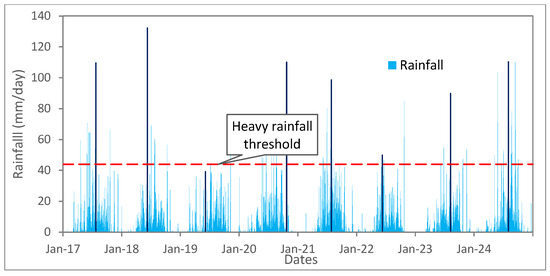
Figure 7.
The area-averaged daily accumulated rainfall from 2017 to 2024.
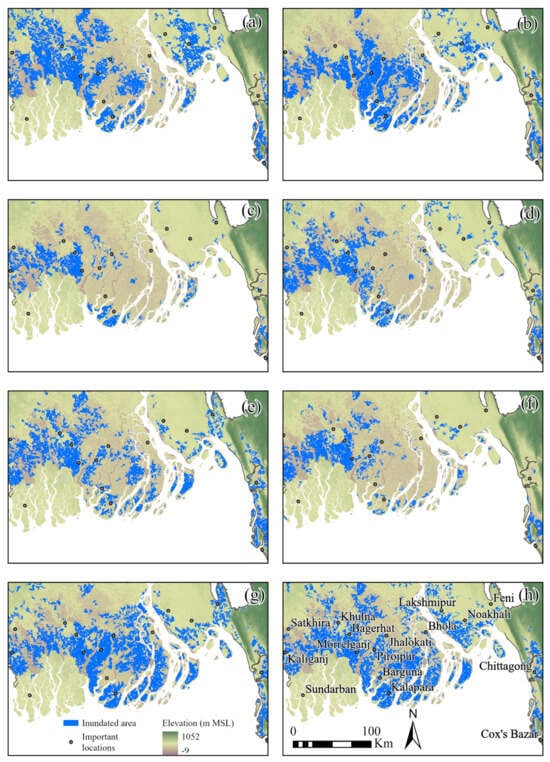
Figure 8.
Inundation in the coastal districts due to monsoon rainfall events of the year (a) 2017, (b) 2018, (c) 2019, (d) 2020, (e) 2021, (f) 2022, (g) 2023, and (h) 2024.
4.2.2. Inundation Due to Cyclone
The extents of inundation during eight tropical cyclones, namely, Mora, Titli, Fani, Amphan, Yaas, Sitrang, Midhili, and Remal, were assessed using SAR imagery and are illustrated in Figure 9. In May 2017, Cyclone Mora made landfall south of Chittagong, with maximum sustained wind speeds of 110 km/h, inundating approximately 6888 sq. km (Figure 9a). Although it struck the southeastern coast, the most severe inundation occurred in the southwestern region, particularly around Morrelganj Upazila. Other moderately affected areas included Maheshkhali, Begumganj (Noakhali district), and Shyamnagar (Satkhira district). Cyclone Titli, classified as a very severe cyclonic storm, made landfall in October 2018 with a maximum sustained surface wind speed of 165 km/h. Although it struck the coastline near northern Andhra Pradesh and southern Odisha, significant inundation was recorded in the coastal districts of Bangladesh, with an affected area of approximately 7958 sq. km, the second-largest among eight major cyclonic events analyzed (Figure 9b). Extensive inundation was observed in Jessore, Cox’s Bazar, Satkania (Chittagong district), Noakhali, and Bhola, while moderate inundation affected regions such as Feni, Morrelganj, and Galachipa (Patuakhali district). Despite the heavy rainfall reported in the southeastern coastal zone, substantial inundations also occurred in Jessore, located in the southwestern coastal region. In May 2019, Cyclone Fani, an extremely severe cyclone with a maximum wind speed of approximately 185 km/h, made landfall near the Odisha coast. Although the landfall occurred at a considerable distance from the Bangladesh coastline, the resulting depression advanced toward the country’s southwest coast, leading to approximately 4934 sq. km of inundation, the smallest affected area among the eight cyclones analyzed (Figure 9c). As a result, the southwest coastal districts exhibited significantly greater inundation compared to the southeast and south-central coastal regions. Considerable inundation was observed in Khulna, Satkhira, Shyamnagar, and Chittagong, with moderate inundation occurring in Chakaria, Barguna, Pirojpur, Morrelganj, Noakhali, Kalapara, and Charfasson (Bhola district). In May 2020, Super Cyclone Amphan, with wind speeds reaching 270 km/h, caused extensive inundation, affecting around 7649 sq. km (Figure 9d). Although it made landfall near the Sundarbans in West Bengal, India, substantial flooding occurred across the southwestern coastal areas and parts of the south-central region. Severely inundated areas included Morrelganj, Kaliganj, and Kalapara, with localized impacts in Chakaria. Over the next two years, the coastal zone experienced relatively lower levels of inundation. In May 2021, Cyclone Yaas (140 km/h) affected approximately 6542 sq. km, despite making landfall in Odisha and West Bengal, India (Figure 9e). In October 2022, Cyclone Sitrang (85 km/h) made landfall in Barisal, Bangladesh, inundating about 6535 sq. km (Figure 9f). Moderate flooding was also observed in Shyamnagar and Chakaria. Cyclone Midhili, which struck in November 2023 with a wind speed of 95 km/h and made landfall in Patuakhali District, caused the second-least inundation among the eight events-approximately 5427 sq. km (Figure 9g). Nevertheless, significant flooding occurred in parts of Kalia, Bagerhat, and Shyamnagar, with additional inundations in Chatkhil (Noakhali district) and Galachipa (Patuakhali district) due to its eastern landfall. Finally, Cyclone Remal in May 2024, with a maximum wind speed of 110 km/h, caused the most extensive inundation, affecting approximately 9243 sq. km (Figure 9h). The cyclone made landfall between Sagar Islands and Khepupara, near Mongla, triggering widespread flooding across the coastline. The most heavily impacted areas included Morrelganj, Kalapara, Hatiya (Noakhali district), Shyamnagar, and Chakaria. Although the eight cyclones exhibited different inundation patterns, the Morrelganj and Chakaria areas were consistently inundated during all events.
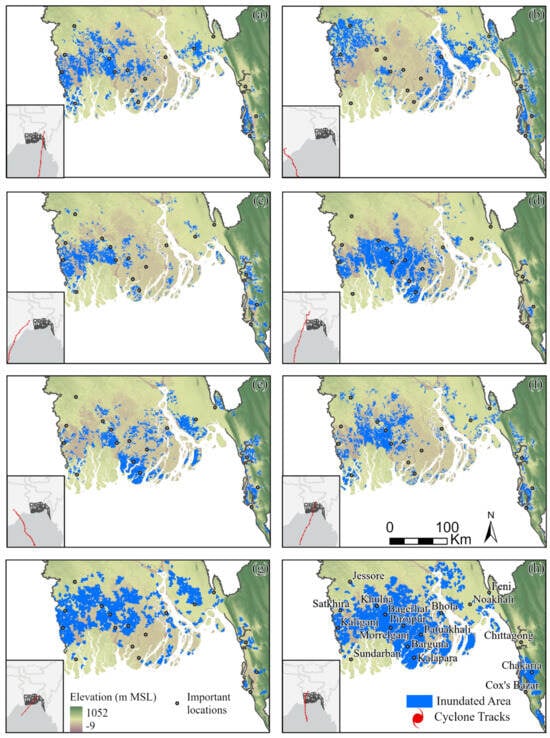
Figure 9.
Inundation in the coastal districts due to the cyclones (a) Mora, (b) Titli, (c) Fani, (d) Amphan, (e) Yaas, (f) Sitrang, (g) Midhili, and (h) Remal.
4.3. Assessment of Flood-Affected Zones
Figure 10 illustrates the flood frequency maps for peak monsoon rainfall and cyclonic events, respectively. Across the coastal region, the western coast shows the most severe impact from monsoon rainfall. According to the classification, large areas in the west—including Morrelganj, Kaliganj, and nearby low-lying regions fall into the high flood-affected category, likely due to their relatively low elevation. In contrast, the central coastal region is predominantly characterized by low to moderate flood vulnerability, with some high-impact zones near Kalapara. The eastern coastal region generally falls within low to moderate flood-affected categories, although Chakaria and surrounding low-lying areas stand out as zones of high flood exposure.
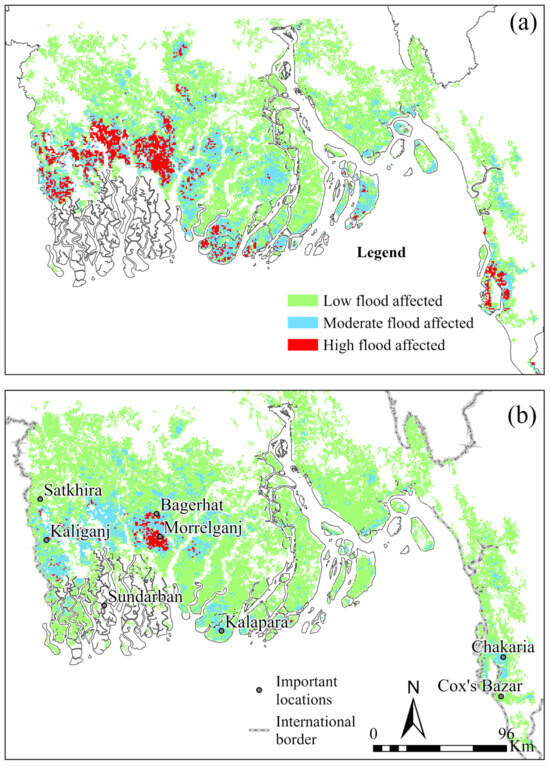
Figure 10.
Flood zoning map for (a) monsoon rainfall and (b) cyclone.
The flood frequency map for cyclonic events, based on inundation data from eight selected cyclones, reveals that Morrelganj and its surrounding areas are classified as highly flood-affected due to repeated cyclone-induced inundation. The western coastline is consistently impacted, leading to a designation of moderate cyclone flood risk, with some localized areas facing high impacts. Portions of the Sundarbans are also affected by cyclone-driven flooding and are marked as low to moderate flood-affected zones. In the central coastal area, particularly near Kalapara, frequent inundation occurs due to its proximity to the shoreline, placing it in the moderately flood-affected category. Meanwhile, in the eastern coastal region, the higher topographic elevation helps limit flood exposure. Flooding here is generally localized, affecting low-lying areas near Chakaria and Cox’s Bazar, which fall mostly within low to moderate impact categories.
Table 3 shows the comparison of flood-affected areas due to monsoon and cyclone events. In the low frequency inundation category, the area affected due to cyclones is quite large (19,085 sq. km) compared to the area of inundation due to monsoonal rainfall (13,829 sq. km). The areas moderately affected by flooding are relatively similar for both events, with 4054 sq. km under monsoon and 3459 sq. km under cyclones. High-impact inundation (i.e., high frequency of inundation) is more extensive during monsoonal rainfall (1626 sq. km) than during cyclonic events (255 sq. km).

Table 3.
The comparison of inundation due to monsoon rainfall and cyclones.
5. Discussion
In this study, we sought to delineate the inundation extent across the coastal districts of Bangladesh, which extend over an area of approximately 47,201 square kilometers [48,49]. This region includes a diverse array of land cover categories and ecosystems, such as built-up regions, croplands, estuaries, mangroves, beaches, and tidal flats. To detect inundation, we employed SAR imagery, focusing specifically on VV polarization. The choice of VV polarization was guided by its relatively higher probability of penetrating through vegetative canopy layers, which enhances the detection of inundated surfaces. In contrast, cross-polarization (VH) is more susceptible to depolarization due to multiple scattering events from heterogeneous land cover components within the radar’s footprint. This scattering reduces signal penetration and complicates the interpretation of inundation extents. In comparison, VV polarization primarily interacts with vertical structures, which limits multiple bounces and reduces signal distortion, thereby improving the reliability of inundation detection. To evaluate the performance of VV versus VH polarizations, we conducted a comparative analysis for a typical coastal pourashava during both a cyclone event and a monsoonal day, as illustrated in Figure 11. The results indicate that VV polarization yields superior inundation mapping performance under both scenarios, confirming its suitability for operational monitoring of flood events in complex coastal land cover.
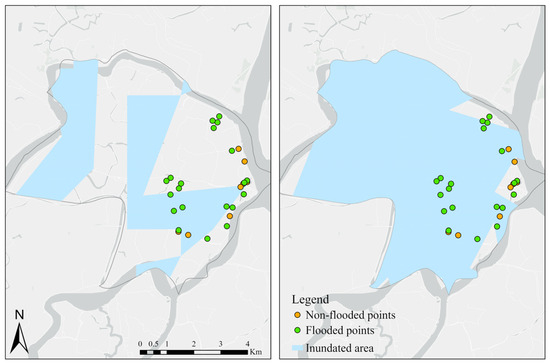
Figure 11.
Comparison between inundation extent derived from VH vs. VV polarization of the SAR image for Chalna Pourashava.
Variations in SAR image quality play a critical role in determining the accuracy of flood extent mapping. Key factors such as spatial and temporal resolution, incidence angle, polarization mode, and frequency band influence the detection and delineation of inundated areas, particularly in complex land cover settings like the coastal regions of Bangladesh. In this study, the SAR imagery used had a spatial resolution of 10 m × 10 m, which may fail to capture small-scale inundations below this threshold. The temporal gap between pre- and post-event images ranged from 1 to 7 days (Table 1), potentially missing rapid flood dynamics driven by tidal influences. Given the study area’s characteristically gentle slope (Figure 1), geometric distortions in backscatter values were considered negligible, although some errors may still occur in urban environments. Additional sources of error, such as radiometric inconsistencies and speckle noise, may also contribute to the misclassification of inundated areas. To address these limitations, ML techniques were employed to enhance classification accuracy.
During the optimization of the change detection threshold, the , SVM model emerged as the most stable approach for inundation identification, demonstrating high accuracy, robustness, and strong discriminative capability. The differing accuracy values between the main evaluation and cross-validation reflect their distinct purposes: the former assesses model performance on a fixed test set, while the latter provides a more generalized estimate by averaging results across multiple data splits. Among the models, SVM consistently outperforms others in both evaluations, highlighting its robustness. This can be attributed to SVM’s ability to maximize class separation margins and effectively handle non-linear data through the kernel trick. KNN performs well in the main evaluation but shows moderate consistency in cross-validation due to its sensitivity to feature scaling, noise, and data distribution. As a lazy learner, KNN’s instance-based approach can lead to variability across folds, especially when the optimal k-value fluctuates. RF performs comparatively poorly in both evaluations. Despite its ensemble design to reduce variance, RF’s underperformance suggests the dataset may lack the complex feature interactions needed for tree-based models. The high cross-validation variability (±0.1670) further indicates instability, likely stemming from its reliance on random sampling and feature selection, which may not align well with the dataset’s structure. However, performance varies across regions and conditions, highlighting the need for context-specific model selection. For instance, it has been reported that the RF classifier, particularly when using VV polarization, outperformed other methods in delineating flood extents in Kerala and Assam, India [24]. In contrast, SVM and unsupervised change detection techniques yielded superior accuracy in another study [25]. Collectively, these findings highlight the significance of tailoring threshold values and model choices to specific geographic and operational contexts, balancing classification performance with computational efficiency to ensure practical applicability. Despite these challenges, the proposed machine learning framework offers scalable potential for flood mapping and risk assessment in other vulnerable regions. Integrating such systems into disaster management can enable more timely and accurate flood warnings, representing a critical step toward adaptive, data-driven resilience strategies.
The observed inundation patterns along the GBM delta coastline are influenced by several hydro-meteorological factors, including tidal conditions, rainfall intensity, and prevailing sea levels. For instance, despite having comparable area-averaged daily rainfall values (~110 mm/day), the extent of inundation varied significantly across the years 2017, 2020, and 2024 (monsoonal rainfall), resulting in flooded areas of 9639 km2, 5396 km2, and 9888 km2, respectively (Figure 8). This variation highlights the role of additional drivers such as tidal phase. Notably, the events in 2017 and 2024 occurred during spring tides, which are typically associated with higher water levels, while the 2020 event coincided with a neap tide, possibly explaining the reduced inundation despite similar rainfall.
The highest inundation for monsoonal rainfall observed during the study period occurred on 7 August 2023, despite a relatively lower daily rainfall of 90 mm. This event took place during a neap tide, yet it resulted in extensive flooding. This anomaly can be attributed to a preceding monsoon depression that crossed the Bangladesh coast between 1–3 August 2023, likely saturating the ground and initiating early inundation. The subsequent rainfall on 7 August exacerbated already critical conditions [69], suggesting that antecedent moisture and pre-event flooding play crucial roles in modulating flood extent.
Findings also corroborate historical reports of coastal flooding events. For example, significant monsoon flooding in June 2019 affecting Feni, Noakhali, Khagrachari, Bandarban, Rangamati, Cox’s Bazar, and Chattogram was documented by the International Federation of Red Cross and Red Crescent Societies [70]. Our analysis confirms inundation in Noakhali and Maheshkhali; however, the other affected districts listed in the IFRC (2019) [70] report primarily experienced upstream riverine flooding rather than coastal inundation. Similarly, continuous heavy rainfall was reported in July 2021, causing severe flooding in Cox’s Bazar Sadar, Teknaf, Ukhiya, and Ramu upazilas [71]. Our satellite-based analysis confirms comparable inundation patterns in these regions (Figure 8e), affirming the utility of remote sensing in capturing localized flood impacts. In August 2024, a series of intense and consecutive rainfall events led to severe flooding across Noakhali, Cumilla, Laxmipur, Feni, and Chattogram [72]. Our analysis similarly indicates widespread coastal inundation in these districts during the same period.
The resulting inundation patterns along the coastline are strongly influenced by the track and landfall location of a tropical cyclone, in addition to hydro-meteorological factors such as wind speed, storm surge, and tidal conditions. This study’s findings align with prior events documented in the literature. For instance, Cyclone Mora (2017) severely impacted eight districts—Bandarban, Rangamati, Khagrachhari, Cox’s Bazar, Chittagong, Noakhali, Bhola, and Feni [73]—and our analysis corroborates similar patterns of inundation in these areas. Cyclone Amphan, categorized as a super cyclone, severely affected Satkhira and Khulna in 2020. Other districts, such as Barguna and Patuakhali, also experienced flooding [74]. We found severely inundated locations, including Morrelganj, Kaliganj, and Kalapara, with localized impacts observed in Chakaria.
Similarly, cyclone Yaas led to widespread inundation in Satkhira, Pirojpur, and Patuakhali, primarily due to elevated water levels from storm surges coinciding with astronomical high tides. The low-lying areas in Khulna, Satkhira, Bagerhat, Barguna, Patuakhali, and Bhola were submerged due to the tidal surge associated with Cyclone Yaas [75]. These observations are further substantiated by our inundation analysis (Figure 10), which also identifies extensive flooding in Satkhira, Pirojpur, Patuakhali, Khulna, Bagerhat, Barguna, and Bhola. The spatial patterns of inundation observed during cyclones Titli, Fani, Sitrang, Midhili, and Remal also display a high degree of similarity with previously reported findings [76]. Notably, for all the cyclones studied, the associated depressions persisted inland for durations ranging from 9 to 30 h post-landfall, contributing to prolonged and extensive inundation in the affected regions [69].
The frequency-based inundation mapping (Figure 10) reveals that the majority of flood-affected areas fall within the low inundation category for both monsoonal and cyclonic events. Notably, cyclones impact a much larger area (19,085 km2) compared to monsoon rainfall events (12,737 km2), indicating the impact of cyclones to be more spatially widespread. In the moderate inundation category, the affected areas are comparable between the two types of events, 4054 km2 for monsoonal floods and 3459 km2 for cyclonic events. This suggests that although cyclones are less frequent, they are capable of producing flood intensities on par with seasonal monsoon systems. In the case of High Inundation Category, the extent of severe flooding is considerably greater during monsoonal periods (1626 km2) than during cyclones (255 km2). This trend underscores the heightened risk of intense inland flooding during prolonged or extreme monsoonal rainfall, which is likely a result of sustained precipitation over larger catchment areas. This highlights the need for distinct response strategies for each type of hydrometeorological event when managing flood risks along the GBM coastline.
Cyclone-induced flooding typically includes both storm surge and intense rainfall, which often occur simultaneously and are difficult to distinguish from one another. The observation that areas like Bagerhat and Morrelganj experience severe flooding during cyclones, while Kalapara faces high flood levels primarily during the monsoon, may indicate inadequate drainage, likely a consequence of the polder system in those regions.
While the flood extent maps derived from SAR imagery provide critical insights into the spatiotemporal dynamics of inundation across the coastal region, several sources of uncertainty may affect the accuracy and interpretation of the results. One major limitation arises from the reliance on backscatter intensity for inundation classification, which can be influenced by surface conditions such as vegetation cover, soil moisture, and built-up infrastructure. These features may either mask floodwaters or exhibit backscatter characteristics similar to open water, potentially leading to misclassification. For instance, smooth surfaces or saturated soils—common in agricultural fields or the mangrove forests of the Sundarbans—may produce low backscatter values indistinguishable from inundated areas. Although visual inspection was employed to minimize such errors, the subjective nature of this approach may still leave room for misinterpretation in certain regions. Additionally, the use of threshold-based classification techniques () may not adequately account for local heterogeneity in land cover and hydrological behavior, particularly in complex coastal environments. The temporal resolution of available SAR imagery poses another challenge; the timing of image acquisition does not always align with the peak of rainfall or cyclone-induced flooding, leading to potential underestimation or overestimation of inundation extents. While efforts were made to select images closest to the event dates, image availability remained a constraint in several cases. For example, the inundation assessment during cyclonic events was based on imagery captured on the day of landfall; however, maximum inundation often occurs before or after landfall due to cumulative rainfall, tidal interactions, and storm surge progression. As such, the presented maps may not fully capture the temporal evolution of flooding. Furthermore, the application of spatial filtering techniques, such as focal mean smoothing, although effective in reducing speckle noise and enhancing image quality, can obscure smaller or linear water bodies, thereby underrepresenting inundation in narrow channels or localized low-lying zones. Another important limitation is the relatively small validation dataset, comprising only 71 locations across flood and non-flood classes. This limited ground truth data restricts the statistical robustness and generalizability of the classification accuracy. These limitations should be carefully considered when interpreting the flood frequency maps and their implications for disaster risk reduction and regional adaptation planning.
We recommend that future studies adopt a multi-temporal analysis framework to more accurately capture the dynamic and rapidly evolving nature of cyclone-induced flooding. Enhancing spatial and temporal resolution through the use of high-frequency satellite constellations should be prioritized to better monitor short-duration and transient flood events. The integration of multi-source data—such as automated gauging stations, UAV-based observations, and other in-situ sensors—with satellite imagery through data fusion techniques can significantly improve the detection of rapid flood onset, particularly in tidal and densely populated urban regions. Additionally, the application of advanced ML and deep learning models—such as convolutional neural networks (CNNs), recurrent neural networks (RNNs), and transformer-based architectures—holds promise for improving classification accuracy and enabling more automated, scalable flood mapping across heterogeneous land cover. In the long term, SAR-based monitoring systems should be further integrated into dynamic flood forecasting models to enhance early warning capabilities and real-time decision support.
6. Conclusions
This study underscores the expanding potential of SAR imagery integrated with ML algorithms in advancing flood inundation monitoring, particularly in coastal and deltaic environments exposed to compound climate hazards. Focusing on the GBM delta coastline of Bangladesh, the application of SVM, RF, and KNN classifiers demonstrated that SVM, achieving 75% accuracy, offers the most reliable performance in flood detection due to its robustness and strong discriminative capability. The analysis of monsoonal and cyclone-induced floods between 2017 and 2024 revealed that high-intensity rainfall events—particularly those exceeding 100 mm/day—triggered widespread inundation in western coastal zones, while storm surges and persistent winds from cyclones led to repeated flooding in southwestern districts. These findings carry broader implications for flood-prone deltas and low-lying coastal regions globally, which face similar compound flooding risks driven by extreme rainfall and tropical cyclones. The use of SAR imagery, unaffected by cloud cover, combined with hydro-meteorological indicators such as rainfall intensity and cyclone tracks, provides a scalable and transferable approach for detecting both immediate flood hotspots and evolving vulnerability patterns under changing climate conditions. Importantly, distinguishing between flood mechanisms—whether rainfall-driven or cyclone-induced—can guide the design of targeted early warning systems, adaptive infrastructure (e.g., raised shelters, improved drainage, embankments), and climate-resilient development plans tailored to regional hazards. Comparative analysis revealed that cyclone events affected larger areas under low-level inundation (19,085 sq. km), whereas monsoonal events resulted in more severe high-impact flooding (1626 sq. km), highlighting the need for differentiated risk management strategies.
As climate extremes grow in frequency and intensity across the globe, we believe the methodological framework and findings of this study provide a valuable foundation for improving early warning systems, disaster preparedness, and long-term resilience in other vulnerable coastal deltas. Future research should emphasize a multi-temporal approach and utilize high-frequency satellite constellations to more effectively capture the rapid dynamics of flooding. Integrating SAR-based flood monitoring into dynamic forecasting models has the potential to significantly enhance real-time flood management and early warning capabilities worldwide—an essential step toward strengthening adaptive capacity and protecting at-risk communities in an era of a warming world.
Author Contributions
Conceptualization, S.; methodology, S.; analysis, N.N.N., M.M.W., S.D. and M.P.H.; validation, S.D. and H.M.M.; writing—original draft preparation, S., N.N.N., M.M.W., S.M.T.Z. and Z.T.; writing—review and editing, A.K.M.S.I. and M.A.H.; supervision, S., A.K.M.S.I. and M.A.H. All authors have read and agreed to the published version of the manuscript.
Funding
This research was funded by the Global Center on Adaptation (GCA).
Data Availability Statement
The data presented in this study are available on request to the corresponding author.
Acknowledgments
This work was supported by the project entitled, “Enhancing Climate Resilience of Coastal Towns of Bangladesh Through Nature-Based Solutions”, carried out by the. Institute of Water and Flood Management (IWFM) of Bangladesh University of Engineering and Technology (BUET).
Conflicts of Interest
The authors declare no conflicts of interest.
References
- Rudra, K. Flood in the GBM Delta. In Rivers of the Ganga-Brahmaputra-Meghna Delta; Springer: Cham, Switzerland, 2018; pp. 125–136. [Google Scholar] [CrossRef]
- Singha, M.; Dong, J.; Sarmah, S.; You, N.; Zhou, Y.; Zhang, G.; Doughty, R.; Xiao, X. Identifying Floods and Flood-Affected Paddy Rice Fields in Bangladesh Based on Sentinel-1 Imagery and Google Earth Engine. ISPRS J. Photogramm. Remote Sens. 2020, 166, 278–293. [Google Scholar] [CrossRef]
- Chakma, P.; Akter, A. Flood Mapping in the Coastal Region of Bangladesh Using Sentinel-1 SAR Images: A Case Study of Super Cyclone Amphan. J. Civ. Eng. Forum 2021, 7, 267. [Google Scholar] [CrossRef]
- Haque, A.; Nicholls, R.J. Floods and the Ganges-Brahmaputra-Meghna Delta. In Ecosystem Services for Well-Being in Deltas: Integrated Assessment for Policy Analysis; Nicholls, R.J., Hutton, C.W., Adger, W.N., Hanson, S.E., Rahman, M.M., Salehin, M., Eds.; Springer International Publishing: Cham, Switzerland, 2018; pp. 147–159. ISBN 978-3-319-71093-8. [Google Scholar]
- Islam, A.S.; Haque, A.; Bala, S.K. Hydrologic Characteristics of Floods in Ganges-Brahmaputra-Meghna (GBM) Delta. Nat. Hazards 2010, 54, 797–811. [Google Scholar] [CrossRef]
- Woodruff, J.D.; Irish, J.L.; Camargo, S.J. Coastal Flooding by Tropical Cyclones and Sea-Level Rise. Nature 2013, 504, 44–52. [Google Scholar] [CrossRef]
- Yilmaz, K.K.; Adler, R.F.; Tian, Y.; Hong, Y.; Pierce, H.F. Evaluation of a Satellite-Based Global Flood Monitoring System. Int. J. Remote Sens. 2010, 31, 3763–3782. [Google Scholar] [CrossRef]
- Chowdhury, E.H.; Hassan, Q.K. Use of Remote Sensing Data in Comprehending an Extremely Unusual Flooding Event over Southwest Bangladesh. Nat. Hazards 2017, 88, 1805–1823. [Google Scholar] [CrossRef]
- Sunkpho, J.; Ootamakorn, C. Real-Time Flood Monitoring and Warning System. Songklanakarin J. Sci. Technol. 2011, 33, 227–235. [Google Scholar]
- Dewan, A.; Kankam-Yeboah, K.; Nishigaki, M. Using Synthetic Aperture Radar (SAR) Data for Mapping River Water Flooding in an Urban Landscape: A Case Study of Greater Dhaka, Bangladesh. J. Japan Soc. Hydrol. Water Resour. 2006, 19, 44–54. [Google Scholar] [CrossRef]
- Voigt, S.; Giulio Tonolo, F.; Lyons, J.; Kucera, J.; Jones, B.; Schneiderhan, T.; Platzeck, G.; Kaku, K.; Hazarika, M.; Czaran, L.; et al. Global Trends in Satellite-Based Emergency Mapping. Science 2016, 353, 247–252. [Google Scholar] [CrossRef]
- Liang, J.; Liu, D. A Local Thresholding Approach to Flood Water Delineation Using Sentinel-1 SAR Imagery. ISPRS J. Photogramm. Remote Sens. 2020, 159, 53–62. [Google Scholar] [CrossRef]
- Wilson, B.; Rashid, H. Monitoring the 1997 Flood in the Red River Valley Using Hydrologic Regimes and RADARSAT Imagery. Can. Geogr./Le Géographe Can. 2005, 49, 100–109. [Google Scholar] [CrossRef]
- Greifeneder, F.; Wagner, W.; Sabel, D.; Naeimi, V. Suitability of SAR Imagery for Automatic Flood Mapping in the Lower Mekong Basin. Int. J. Remote Sens. 2014, 35, 2857–2874. [Google Scholar] [CrossRef]
- Tripathi, G.; Pandey, A.C.; Parida, B.R.; Kumar, A. Flood Inundation Mapping and Impact Assessment Using Multi-Temporal Optical and SAR Satellite Data: A Case Study of 2017 Flood in Darbhanga District, Bihar, India. Water Resour. Manag. 2020, 34, 1871–1892. [Google Scholar] [CrossRef]
- Dasari, K.; Anjaneyulu, L.; Jayasri, P.V.; Prasad, A.V.V. Importance of Speckle Filtering in Image Classification of SAR Data. In Proceedings of the 2015 International Conference on Microwave, Optical and Communication Engineering (ICMOCE), Bhubaneswar, India, 18–20 December 2015; pp. 349–352. [Google Scholar] [CrossRef]
- Shen, X.; Wang, D.; Mao, K.; Anagnostou, E.; Hong, Y. Inundation Extent Mapping by Synthetic Aperture Radar: A Review. Remote Sens. 2019, 11, 879. [Google Scholar] [CrossRef]
- Farhadi, H.; Esmaeily, A.; Najafzadeh, M. Flood Monitoring by Integration of Remote Sensing Technique and Multi-Criteria Decision Making Method. Comput. Geosci. 2022, 160, 105045. [Google Scholar] [CrossRef]
- Esfandiari, M.; Jabari, S.; McGrath, H.; Coleman, D. Flood Mapping Using Random Forest and Identifying the Essential Conditioning Factors; A Case Study in Fredericton, New Brunswick, Canada. ISPRS Ann. Photogramm. Remote Sens. Spat. Inf. Sci. 2020, V-3–2020, 609–615. [Google Scholar] [CrossRef]
- Malinowski, R.; Groom, G.; Schwanghart, W.; Heckrath, G. Detection and Delineation of Localized Flooding from WorldView-2 Multispectral Data. Remote Sens. 2015, 7, 14853–14875. [Google Scholar] [CrossRef]
- Xie, M.; Jiang, Z.; Sainju, A.M. Geographical Hidden Markov Tree for Flood Extent Mapping. In Proceedings of the 24th ACM SIGKDD International Conference on Knowledge Discovery & Data Mining, London, UK, 19–23 August 2018; Association for Computing Machinery: New York, NY, USA, 2018; pp. 2545–2554. [Google Scholar]
- Lim, J.; Lee, K. Flood Mapping Using Multi-Source Remotely Sensed Data and Logistic Regression in the Heterogeneous Mountainous Regions in North Korea. Remote Sens. 2018, 10, 1036. [Google Scholar] [CrossRef]
- Lin, K.; Chen, H.; Xu, C.-Y.; Yan, P.; Lan, T.; Liu, Z.; Dong, C. Assessment of Flash Flood Risk Based on Improved Analytic Hierarchy Process Method and Integrated Maximum Likelihood Clustering Algorithm. J. Hydrol. 2020, 584, 124696. [Google Scholar] [CrossRef]
- Rana, V.K.; Suryanarayana, T.M.V. Evaluation of SAR Speckle Filter Technique for Inundation Mapping. Remote Sens. Appl. Soc. Environ. 2019, 16, 100271. [Google Scholar] [CrossRef]
- Tanim, A.H.; McRae, C.B.; Tavakol-davani, H.; Goharian, E. Flood Detection in Urban Areas Using Satellite Imagery and Machine Learning. Water 2022, 14, 1140. [Google Scholar] [CrossRef]
- Novianti, L.; Ermatita; Abdiansah; Handyani, A.S.; Rahmadani, N.; Husni, N.L. Machine Learning Application of Flood Detecting and Mapping in Urban Area with Geographic Information Data. In Proceedings of the 8th International Conference on Global Innovations (FIRST-ESCSI 2024), Palembang, Indonensia, 21–22 October 2024; Atlantis Press: Dordrecht, The Netherlands, 2025; pp. 374–384. [Google Scholar]
- Zhang, X.; Chan, N.W.; Pan, B.; Ge, X.; Yang, H. Mapping Flood by the Object-Based Method Using Backscattering Coefficient and Interference Coherence of Sentinel-1 Time Series. Sci. Total Environ. 2021, 794, 148388. [Google Scholar] [CrossRef] [PubMed]
- Soria-Ruiz, J.; Fernandez-Ordoñez, Y.M.; Ambrosio-Ambrosio, J.P.; Escalona-Maurice, M.J.; Medina-García, G.; Sotelo-Ruiz, E.D.; Ramirez-Guzman, M.E. Flooded Extent and Depth Analysis Using Optical and SAR Remote Sensing with Machine Learning Algorithms. Atmosphere 2022, 13, 1852. [Google Scholar] [CrossRef]
- Halder, K.; Ghosh, A.; Srivastava, A.K.; Pal, S.C.; Chatterjee, U.; Bisai, D.; Ewert, F.; Gaiser, T.; Islam, A.R.M.T.; Alam, E.; et al. SAR-Driven Flood Inventory and Multi-Factor Ensemble Susceptibility Modelling Using Machine Learning Frameworks. Geomat. Nat. Hazards Risk 2024, 15, 2409202. [Google Scholar] [CrossRef]
- Aristizabal, F.; Judge, J.; Monsivais-Huertero, A. High-Resolution Inundation Mapping for Heterogeneous Land Covers with Synthetic Aperture Radar and Terrain Data. Remote Sens. 2020, 12, 900. [Google Scholar] [CrossRef]
- Liu, B.; Li, X.; Zheng, G. Automatic Mapping of Tropical Cyclone-Induced Coastal Inundation in SAR Imagery Based on Clustering of Deep Features. In Proceedings of the IGARSS 2020—2020 IEEE International Geoscience and Remote Sensing Symposium, Waikoloa, HI, USA, 26 September–2 October 2020; pp. 5765–5768. [Google Scholar]
- Rahman, M.; Ningsheng, C.; Islam, M.M.; Dewan, A.; Iqbal, J.; Washakh, R.M.A.; Shufeng, T. Flood Susceptibility Assessment in Bangladesh Using Machine Learning and Multi-Criteria Decision Analysis. Earth Syst. Environ. 2019, 3, 585–601. [Google Scholar] [CrossRef]
- Rana, S.M.; Kamruzzaman, M.; Rajib, M.A.; Rahman, M.M. Changes in Cyclone Pattern with Climate Change Perspective in the Coastal Regions of Bangladesh. Environ. Res. Eng. Manag. 2011, 56, 20–27. [Google Scholar] [CrossRef]
- Chan, F.K.S.; Paszkowski, A.; Wang, Z.; Lu, X.; Mitchell, G.; Tran, D.D.; Warner, J.; Li, J.; Chen, Y.D.; Li, N.; et al. Building Resilience in Asian Mega-Deltas. Nat. Rev. Earth Environ. 2024, 5, 522–537. [Google Scholar] [CrossRef]
- Alam, E.; Dominey-Howes, D. A New Catalogue of Tropical Cyclones of the Northern Bay of Bengal and the Distribution and Effects of Selected Landfalling Events in Bangladesh. Int. J. Climatol. 2015, 35, 801–835. [Google Scholar] [CrossRef]
- Alam, M.M.; Hossain, M.A.; Shafee, S. Frequency of Bay of Bengal Cyclonic Storms and Depressions Crossing Different Coastal Zones. Int. J. Climatol. 2003, 23, 1119–1125. [Google Scholar] [CrossRef]
- Dastagir, M.R. Modeling Recent Climate Change Induced Extreme Events in Bangladesh: A Review. Weather Clim. Extrem. 2015, 7, 49–60. [Google Scholar] [CrossRef]
- MoEF Bangladesh Cimate Change Strategy and Action Plan 2009; Government of the People’s Republic of Bangladesh: Dhaka, Bangladesh, 2009; pp. 80–85.
- Nasher, N.R.; Karim, K.R.; Islam, M.Y. Spatio-Temporal Variation of Cyclone Intensity over the Coastal Region of Bangladesh Using 134 Years Track Analysis. Trop. Cyclone Res. Rev. 2022, 11, 16–25. [Google Scholar] [CrossRef]
- Rahaman, M.; Esraz-Ul-Zannat, M. Evaluating the Impacts of Major Cyclonic Catastrophes in Coastal Bangladesh Using Geospatial Techniques. SN Appl. Sci. 2021, 3, 727. [Google Scholar] [CrossRef]
- Wu, S.; Zhou, X.; Reyns, J.; Yamazaki, D.; Yin, J.; Li, X. Climate Change and Urban Sprawl: Unveiling the Escalating Flood Risks in River Deltas with a Deep Dive into the GBM River Delta. Sci. Total Environ. 2024, 947, 174703. [Google Scholar] [CrossRef]
- Chowdhury, M.R. An Assessment of Flood Forecasting in Bangladesh: The Experience of the 1998 Flood. Nat. Hazards 2000, 22, 139–163. [Google Scholar] [CrossRef]
- Flood Forecasting & Warning Centre, BWDB, Bangladesh. Available online: https://www.ffwc.gov.bd/ (accessed on 18 June 2025).
- FFWC. Annual Flood Report. 2021. Available online: http://www.ffwc.gov.bd/images/annual21.pdf (accessed on 18 June 2025).
- FFWC. Annual Flood Report 2014; FFWC: Dhaka, Bangladesh, 2014. [Google Scholar]
- Paszkowski, A.; Goodbred, S.; Borgomeo, E.; Khan, M.S.A.; Hall, J.W. Geomorphic Change in the Ganges–Brahmaputra–Meghna Delta. Nat. Rev. Earth Environ. 2021, 2, 763–780. [Google Scholar] [CrossRef]
- Rahman, S.; Islam, A.K.M.S.; Saha, P.; Tazkia, A.R.; Krien, Y.; Durand, F.; Testut, L.; Islam, G.M.T.; Bala, S.K. Projected Changes of Inundation of Cyclonic Storms in the Ganges–Brahmaputra–Meghna Delta of Bangladesh Due to SLR by 2100. J. Earth Syst. Sci. 2019, 128, 145. [Google Scholar] [CrossRef]
- Brown, S.; Nicholls, R.J. Subsidence and Human Influences in Mega Deltas: The Case of the Ganges-Brahmaputra-Meghna. Sci. Total Environ. 2015, 527–528, 362–374. [Google Scholar] [CrossRef]
- Kausher, A.; Kay, R.C.; Asaduzzaman, M.; Paul, S. Climate Change and Sea-Level Rise: The Case of the Coast. In The Implications of Climate and Sea–Level Change for Bangladesh; Springer: Dordrecht, The Netherlands, 1996; pp. 335–405. [Google Scholar]
- Reitz, M.D.; Pickering, J.L.; Goodbred, S.L.; Paola, C.; Steckler, M.S.; Seeber, L.; Akhter, S.H. Effects of Tectonic Deformation and Sea Level on River Path Selection: Theory and Application to the Ganges-Brahmaputra-Meghna River Delta. J. Geophys. Res. Earth Surf. 2015, 120, 671–689. [Google Scholar] [CrossRef]
- Sarker, M.H.; Akter, J.; Ferdous, M.R.; Noor, F. Sediment Dispersal Processes and Management in Coping with Climate Change in the Meghna Estuary, Bangladesh. IAHS-AISH Publ. 2011, 349, 203–217. [Google Scholar]
- Rahman, R.; Salehin, M. Flood Risks and Reduction Approaches in Bangladesh BT. In Disaster Risk Reduction Approaches in Bangladesh; Shaw, R., Mallick, F., Islam, A., Eds.; Springer: Tokyo, Japan, 2013; pp. 65–90. ISBN 978-4-431-54252-0. [Google Scholar]
- IFRC. Emergency Appeal: Cyclone Remal. 2024. Available online: https://adore.ifrc.org/Download.aspx?FileId=839180 (accessed on 4 May 2025).
- Ahmed, B. The Root Causes of Landslide Vulnerability in Bangladesh. Landslides 2021, 18, 1707–1720. [Google Scholar] [CrossRef]
- Wang, G.; Hu, H.; Islam, A.R.M.T.; Akter, M.Y.; Fattah, M.A.; Kabir, Z.; Hasan, M.G.; Islam, M.A.; Arabameri, A.; Pal, S.C.; et al. Spatiotemporal Rainfall Concentration and Erosivity in a Tropical Monsoon Country. Theor. Appl. Climatol. 2025, 156, 251. [Google Scholar] [CrossRef]
- Azad, M.A.K.; Islam, A.R.M.T.; Ayen, K.; Rahman, M.S.; Shahid, S.; Mallick, J. Changes in Monsoon Precipitation Patterns over Bangladesh and Its Teleconnections with Global Climate. Theor. Appl. Climatol. 2022, 148, 1261–1278. [Google Scholar] [CrossRef]
- Sentinel-1 Algorithms|Google Earth Engine. Available online: https://developers.google.com/earth-engine/guides/sentinel1 (accessed on 18 June 2025).
- Haibo, H.; Garcia, E.A. Learning from Imbalanced Data. IEEE Trans. Knowl. Data Eng. 2009, 21, 1263–1284. [Google Scholar] [CrossRef]
- Tsamardinos, I.; Greasidou, E.; Borboudakis, G. Bootstrapping the Out-of-Sample Predictions for Efficient and Accurate Cross-Validation. Mach. Learn. 2018, 107, 1895–1922. [Google Scholar] [CrossRef]
- Bakirarar, B.; Elhan, A.H. Class Weighting Technique to Deal with Imbalanced Class Problem in Machine Learning: Methodological Research. Turkiye Klin. J. Biostat. 2023, 15, 19–29. [Google Scholar] [CrossRef]
- Breiman, L. Random Forests. Mach. Learn. 2001, 45, 5–32. [Google Scholar] [CrossRef]
- Cortes, C.; Vapnik, V. Support-Vector Networks. Mach. Learn. 1995, 20, 273–297. [Google Scholar] [CrossRef]
- Evgeniou, T.; Pontil, M. Support Vector Machines: Theory and Applications. In Machine Learning and Its Applications; Springer Science & Business Media: Berlin/Heidelberg, Germany, 2001; pp. 249–257. [Google Scholar]
- Mucherino, A.; Papajorgji, P.J.; Pardalos, P.M. K-Nearest Neighbor Classification. In Data Mining in Agriculture; Springer: New York, NY, USA, 2009; pp. 83–106. [Google Scholar]
- Fawcett, T. An Introduction to ROC Analysis. Pattern Recognit. Lett. 2006, 27, 861–874. [Google Scholar] [CrossRef]
- Bradley, A.P. The Use of the Area under the ROC Curve in the Evaluation of Machine Learning Algorithms. Pattern Recognit. 1997, 30, 1145–1159. [Google Scholar] [CrossRef]
- Ross, A.; Willson, V.L. Paired Samples T-Test. In Basic and Advanced Statistical Tests; SensePublishers: Rotterdam, The Netherlands, 2017; pp. 17–19. [Google Scholar]
- Bangladesh Meteorological Department (BMD). Available online: https://live8.bmd.gov.bd/ (accessed on 14 May 2025).
- Indian Meteorological Department (IMD). Available online: https://mausam.imd.gov.in/ (accessed on 14 May 2025).
- IFRC. Information Bulletin: Bangladesh Monsoon Floods. 2019. Available online: https://www.ifrc.org/docs/Appeals/16/IBBDmf160719.pdf (accessed on 4 May 2025).
- BRAC. Heavy Rainfall Across Rohingya Camps. 2021. Available online: https://fscluster.org/sites/default/files/documents/sitrep2-heavy-rainfall-at-camps-28-july-2021.pdf (accessed on 4 May 2025).
- ICCG. Bangladesh: Eastern Flash Floods. 2024. Available online: https://www.unocha.org/publications/report/bangladesh/bangladesh-eastern-flash-floods-2024-situation-report-no-02-30-august-2024 (accessed on 4 May 2025).
- IFRC. Emergency Plan of Action (EPoA) Bangladesh: Cyclone Mora. 2017. Available online: https://adore.ifrc.org/Download.aspx?FileId=163347 (accessed on 4 May 2025).
- IFRC. Bangladesh: Cyclone Amphan Report. 2021. Available online: https://reliefweb.int/report/bangladesh/bangladesh-cyclone-final-report-early-action-eap2018bd01 (accessed on 26 April 2025).
- NAWG; IMWG. Cyclone Yaas—Light Coordinated Joint Needs Analysis. 2021. Available online: https://reliefweb.int/report/bangladesh/cyclone-yaas-light-coordinated-joint-needs-analysis-needs-assessment-working-group (accessed on 26 April 2025).
- IFRC. Operation Update Report. 2024. Available online: https://adore.ifrc.org/Download.aspx?FileId=839986 (accessed on 4 May 2025).
Disclaimer/Publisher’s Note: The statements, opinions and data contained in all publications are solely those of the individual author(s) and contributor(s) and not of MDPI and/or the editor(s). MDPI and/or the editor(s) disclaim responsibility for any injury to people or property resulting from any ideas, methods, instructions or products referred to in the content. |
© 2025 by the authors. Licensee MDPI, Basel, Switzerland. This article is an open access article distributed under the terms and conditions of the Creative Commons Attribution (CC BY) license (https://creativecommons.org/licenses/by/4.0/).